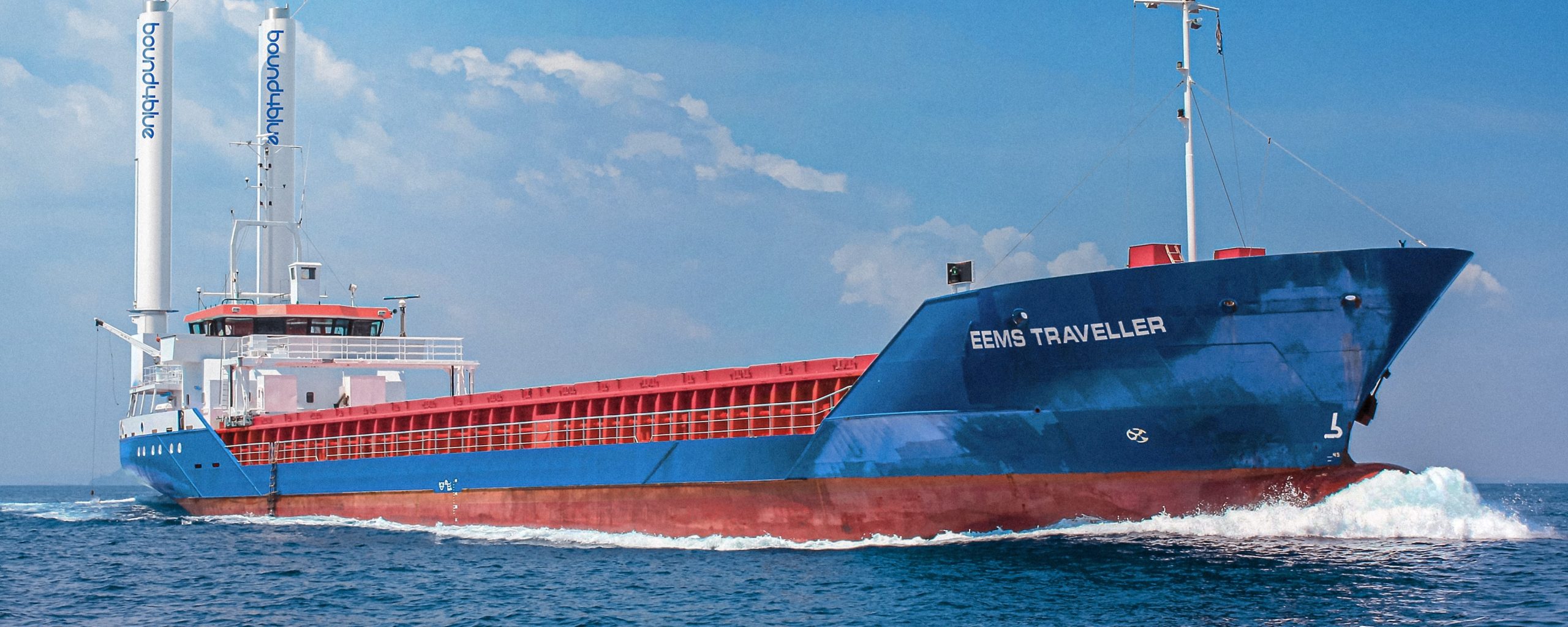There is no mistaking Cristina Aleixendri’s enthusiasm – and competence – when it comes to talking about how wind-assisted shipping is on the verge of making a planet-changing comeback.
Aleixendri founded a company called bound4blue with two fellow Spaniards in 2014 to develop sail technology inspired by their training in aeronautical engineering.
Dream come true
‘When we started, we were seen as crazy engineers for wanting to bring sails back to ships,’ she said. ‘But when we speak to shipowners today, they tell us we’ll go back to wind and it will never be abandoned.’
It’s easy to understand why. The shipping industry accounts for about 3% of global greenhouse-gas emissions and is trying to move away from heavy fuel oil, which is highly polluting.
‘Wind-propulsion technology will become a standard,’ said Aleixendri. ‘It started as a dream of mine. Now, I see it less as a dream and more of a reality.’
Not only has Barcelona-based bound4blue attracted growing interest from shipping firms in its wind-assisted propulsion system but Aleixendri has achieved significant personal recognition for her efforts.
In 2019, she made the Forbes 30 Under 30 list for manufacturing and industry in Europe. The following year, Aleixendri won the European Institute of Innovation and Technology Woman Award recognising inspiring female entrepreneurs.
Wind in the sails
Now, bound4blue is coordinating an EU-funded sails project that borrows the company’s name and runs for two years through February 2024. There’s big room for growth in wind-assisted shipping.
As of September 2022, only 21 large commercial ships globally were equipped with the ability to harness wind energy, according to the International Windship Association. Though predicted to more than double to as many as 50 vessels this year, that’s still a drop in the ocean compared with the global fleet.
“
It’s a massive market.
Wind energy is viable for a variety of vessels, including cargo carriers, tankers, ferries and cruise ships, according to Aleixendri.
‘It’s a massive market because there are more than 60 000 ships sailing worldwide that could benefit from such solutions,’ she said. ‘This is very nascent.’
As 2023 dawned, the entry into force of new regulations by the International Maritime Organization on energy efficiency and carbon emissions is also expected to spur growth.
‘I think it’s the right moment to invest in wind propulsion – it’s a very sweet spot for us,’ said Aleixendri, who is her company’s chief operating officer and earned a Master of Sciences degree in aerospace engineering from the Polytechnic University of Catalonia.
Suction fan
Bound4blue has developed what’s called an autonomous suction-based sail, which looks nothing like a traditional one. It has the appearance of a cylinder-shaped tower that rises from the ship’s deck.
Traditional sails work by ‘‘catching the wind’’. The wind creates a higher-pressure area behind the sail compared to its other side. This difference in pressure generates a force that propels the ship forward, known as “lift”.
By contrast, bound4blue’s ‘‘eSAIL’’ contains a suction fan to draw air inside the tower as wind flows around it, creating stronger lift to power the boat.
This results in six or seven times the lift of a conventional rigid sail and could reduce fuel consumption by up to 40% if combined with better vessel design and adjustments in routes to take advantage of prevailing winds, according to Aleixendri.
The eSAIL is best suited for the types of windy conditions found in the North Atlantic and North Pacific, she said – though its use is by no means exclusive to those routes.
Largest suction sail in the world being installed at a shipyard. © bound4blue, 2021
Emission savings will vary, depending on the general wind conditions on different routes. For example, bound4blue estimates that a merchant ship sailing the 25 000 kilometres from southern Brazil to north-eastern China could save 26% on fuel and emissions.
While it’s still early days, some first movers have already reported savings of 15%. Bound4blue has also signed a range of deals with shipping firms including Japan’s Marubeni and French-owned Louis Dreyfus Armateurs.
‘We have more demand than we can supply today, so we’re very happy about how it’s going,’ said Aleixendri.
While new technology has previously been seen as risky to install on ships, wind-assisted options like bound4blue’s are starting to make economic sense and can pay for themselves in fuel savings within five years, she said.
‘In the end, wind propulsion is providing free, renewable energy that you don’t have to store or invest in infrastructure to supply,’ said Aleixendri.
Vessel design
Amid the promise of wind-based options, a challenge arises: ensuring they are properly implemented to achieve their full performance potential or preventing negative knock-on effects on how a ship runs.
So another EU-funded project, OPTIWISE, is investigating how the overall design of vessels can be adjusted to optimise wind-assisted propulsion.
Better attuning ships to the technology can help improve sailing efficiency and emission savings, according to Rogier Eggers, who leads the three-year project running through May 2025.
Design modifications could also help overcome some of the potential negative consequences of installing sails on ships. Doing so may, for instance, create an obstacle for passing under objects like cranes in ports or even affect ships in such a way that they struggle to stay on course.
“
We are at the start with shipping in moving towards a zero-emission future.
‘That’s simply not acceptable, so it’s required to look at the shape of the hull and appendages such as rudders to make sure that you get the ship in balance,’ said Eggers, a senior project manager at Dutch maritime research institute MARIN.
Over the next couple of years, OPTIWISE plans to use scale models of ships several metres in length to test wind systems and the effects of technological improvements in various sea conditions. The project also intends to employ computer-based voyage simulations and machine learning.
Innovations could deliver savings of well over 30% in carbon emissions, maybe even reaching as much as 50%, if effectively delivered, according to Eggers.
Blast from the past
If wind technologies can be successfully integrated, methods like suction sails, wing sails and cylindrical spinning rotor sails being produced by partners in OPTIWISE could gain real traction, he said.
Adoption of such rotor sails would resurrect a wind-based technology invented a century ago by Anton Flettner, a German engineer. It failed to become widely adopted as a result of the growing popularity of diesel fuel at the time.
‘Several suppliers have been pretty active with wind technology and have been getting increased interest from the shipping market for installations,’ said Eggers. ‘Before, there was a big reluctance to put such things on ships, but devices like Flettner rotors, suction sails and wing sails are now gradually being trusted by the industry.’
This transition promises to set the maritime sector on a course towards slashing emissions.
‘We are at the start with shipping in moving towards a zero-emission future,’ said Eggers. ‘The number of ships equipped now with wind propulsion is still tiny compared to the world fleet, but the hope is that we will soon be seeing hundreds of ships being equipped per year.’
EU Mission: Restore our Ocean and Waters
Through research, innovation, public engagement and investment, one of the aims of the EU Mission “Restore our Ocean and Waters” is to make the blue economy more sustainable.
Developing net-zero maritime transport is key to achieving a blue economy that is carbon-neutral and circular.
Read more here.



